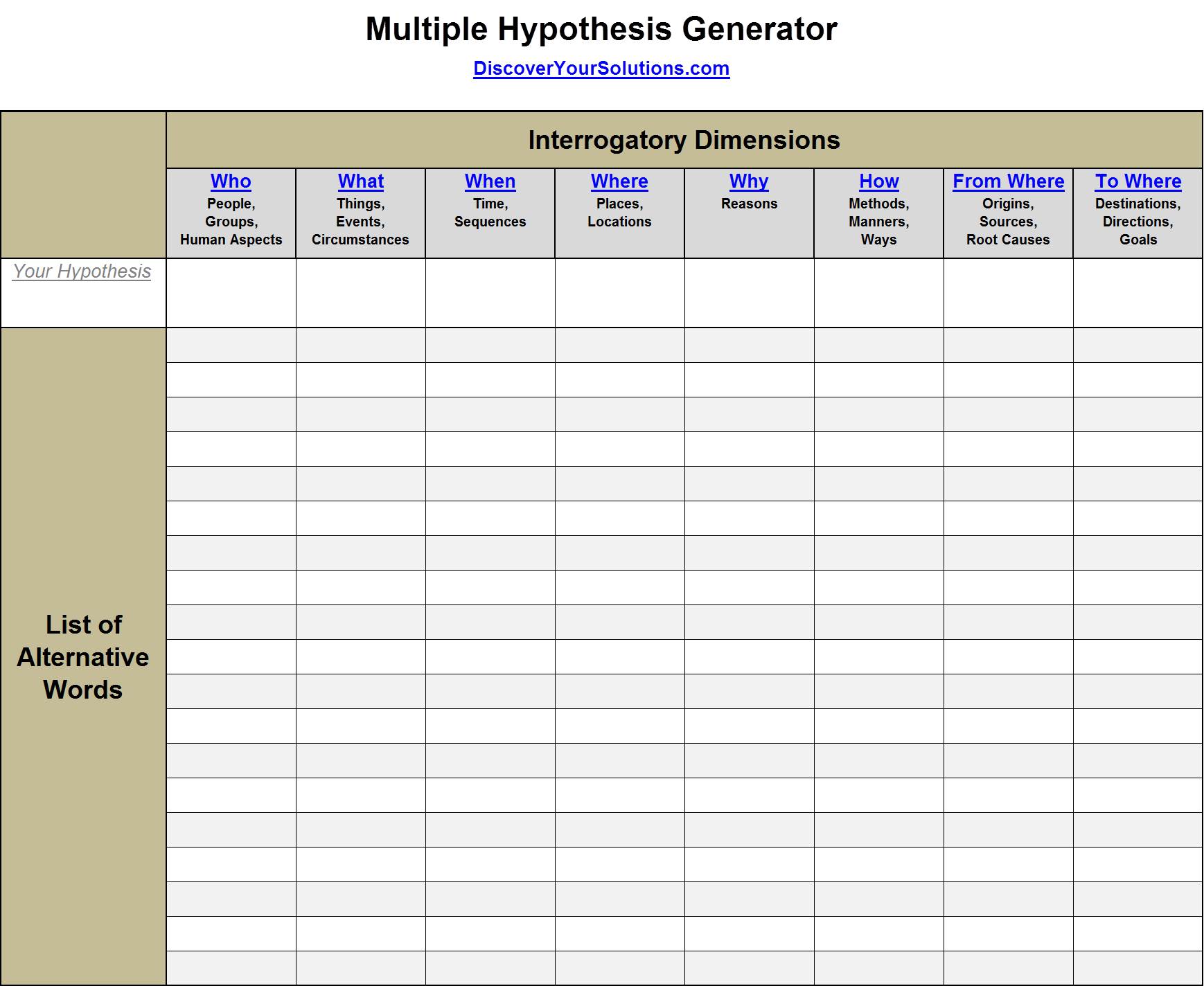
Multiple Hypothesis Generator
Create many possible solutions.

Use our Multiple Hypothesis Generator to develop a large set of possible solutions from one feasible solution that you already have.
Part I: Create Multiple Hypotheses
Step 1: Begin with a single hypothesis. If you don't already have a feasible solution, go to our Hypothesis Generator tool and create one.
Step 2: Take a plausible hypothesis and identify: Who, What, When, Where, Why, How, From Where, and To Where. These are the interrogatory words inherent in your hypothesis.
Step 3: Use the Form below and write the integoratory words from your initial solution into the boxes across the first row (labeled "Your Hypothesis").
Helpful Hint:
If you can't quickly come up with a word to fill into a box, just skip it and go to the next one.
Step 4: Create a list of as many possible alternatives words for the Who. Write your alternative words in the 'Who' column (2nd column in diagram below).
Helpful Hint:
You may want to use a Thesaurus to find alternatives words.
Step 5: Repeat Step 4 and develop alternative words for the rest of your interrogatory dimensions: What, When, Where, Why, How, From Where, and To Where.
Part II: Interchange Interrogatory Words to Create More Solutions
Step 1: Next, create a new list of all of the possible alternative hypotheses by interchanging the interrogatory words you created using the Multiple Hypotheses Generator. Just mix-and-match them until you run out of ideas.
Step 2: Identify all of the mutually exclusive permutations.
Step 3: Throw out the hypotheses that make no sense.
Part III: Interchange Relational Words to Create More Solutions
Step 1: In the next step, identify the relational words in your remaining hypotheses. (See our Relational Words tool for a generic list of relational words.)
Step 2: Create a new list of all of the possible alternative hypotheses by interchanging the relational words. As before, just mix-and-match your relational words until you run out of ideas.
Step 3: Identify all of the mutually exclusive permutations.
Step 4: Next, make a final list of all of the new hypotheses that make sense.
Part IV: Rank the Credibility of Your Solutions
Step 1: Assign a credibility score to each one of the remaining alternative hypotheses. Use 1 for least credible and 10 for most credible.
Step 2: Rank your hypotheses from most credible to least credible.
Multiple Hypotheses Generator Form: Use this form to create multiple solutions from a single hypothesis. (For Part I & Part II above.)

PRINTABLE: Excel version of Multiple Hypothesis Generator.xlsx (Click link to download Excel version).
PRINTABLE: Word version of Multiple Hypothesis Generator.docx (Click link to download Word version).
PRINTABLE: PDF version of Multiple Hypothesis Generator.pdf (Click link to download PDF version).
Related Tools:
- Hypothesis Generator: Use this tool to create a potential solution.
- Hypothesis Testing Matrix: Test and rank your solutions.
- Rival Hypotheses: Create other ways to explain the same set of data.
- Analysis of Competing Hypotheses: Free computer program to evaluate multiple hypotheses.
- Create Solutions: This section of our Toolkit has many other tools for generating solutions.
Sources:
 |
Handbook of Analytic Tools and Techniques by Randolph H. Pherson, Reston, VA: Pherson Associates, 2008. |
 |
Structured Analytic Techniques For Intelligence Analysis by Richards J. Heuer Jr. and Randolph H. Pherson, Washington, DC: CQ Press, 2011. |

